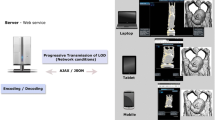Abstract
The evolution of mobile network and the popularization of mobile devices; the demand for multimedia services and 3D graphics applications on limited resource devices is more contemporary. Most of the works on multimedia transmission are focused on bit errors and packet losses due to the fading channel environment of a wireless network. Error resilient multimedia is significant research topic which can be adapted to the different conditions in a wireless environment. The current solutions in transmission of multimedia across different networks include some type of transcoder where the source is partially or fully decoded, and re-encoded to suit the network conditions. This paper introduces a flexible progressive coding framework for 3D meshes, which can be adapted to the different conditions imposed by wired and wireless channels at the bitstream level. By avoiding the computationally complex steps of transcoding between networks, could deteriorate decoded model quality. The framework also allows refined degradation of model quality when the network conditions are poor due to congestion or deep fades.
Similar content being viewed by others
References
N. Dyn, D. Levin and J. A. Gregory, “A butterfly subdivision scheme for surface interpolatory with tension control,” ACM transactions on Graphics 9(1) (1990) 160–169.
D. Zorin, P. Schröder and W. Sweldens, “Interpolating subdivision for meshes with arbitrary topology,” in Computer Graphics Proceedings (SIGGRAPH 96) (1996) 189–192.
R.H. Bartels and F.F. Samavati, “Reversing subdivision rules: Local linear conditions and observations on inner products,” Journal of Computational and Applied Mathematics, Vol. 119, No. (1–2) (2000) pp. 29–67.
F.F. Samavati, N. Mahdavi-Amiri and R.H. Bartels, “Multiresolution surfaces having arbitrary topologies by a reverse Doo subdivision method,” Computer Graphics Forum 21(2) (2002) 121–136.
X.N. Luo, N. Liu and C.Y. Gao, “Fairing geometric modeling based on 4-point interpolatory subdivision scheme,” Journal of Computational and Applied Mathematics 163(1) (2004) 189–197.
W. Sweldens, “The lifting scheme: A custom-design construction of biorthogonal wavelets,” Applied and Computational Harmonic Analysis, Vol. 3, No. 2 (1996) pp. 186–200.
X.N. Luo, H. Nie, Y. Li and Z.X. Luo, “Recurrence surfaces on arbitrary quadrilateral mesh,” Journal of Computational and Applied Mathematics 144(1-2) (2002) 221–232.
H. Hoppe, “Progressive meshes,” Computer Graphics (SIGGRAPH’96 Proceedings) (1996) 99–108.
V. Jingqi, S. Pengfei and Z. David, “Mesh simplification with hierarchical shape analysis and iterative edge contraction,” Visualization and Computer Graphics, IEEE Transactions on, Vol. 10, No. 2 (March-April 2004) pp. 142–151.
K. Myeong-Cheol and C. Yoon-Chul, “3D Mesh simplification for effective network transmission,” High Speed Networks and Multimedia Communications 5th IEEE International Conference on 3-5 (July 2002) pp. 284–288.
M. Isenburg, P. Lindstrom, S. Gumhold and J. Snoeyink, “Large mesh simplification using processing sequences,” Visualization, 2003. VIS 2003. IEEE, 19-24 (Oct. 2003) pp. 465–472.
S. Valette and P. Prost, “Wavelet-based multiresolution analysis of irregular surface meshes,” Visualization and Computer Graphics, IEEE Transactions on, Vol 10, No. 2 (March-April 2004).
R. Pajarola and C. DeCoro, “Efficient implementation of real-time view-dependent multiresolution meshing,” Visualization and Computer Graphics, IEEE Transactions on, Vol. 10, No. 3 (May-June 2004).
T. Akenine-Möller and J. Ström, “Graphics for the masses: A hardware rasterization architecture for mobile phones,” in ACM Transactions of Graphics (Proceedings of ACM SIGGRAPH), Vol. 22, No. 3 (July 2003) pp. 801-808.
J. M. Shapiro, “Embedded image coding using zerotrees of wavelet coefficients,” IEEE Trans. Signal Processing, Vol. 41 (Dec. 1993) pp. 3445–3462.
A. Said and W. A. Pearlman, “A new and efficient image codec based on set partitioning in hierarchical trees,” IEEE Transactions on Carcuits and Systems for Vadeo Tech (June 1996).
D. Mukherjee and S.K. Mitra, “Vector SPIHT for embedded wavelet video and image coding,” Circuits and Systems for Video Technology, IEEE Transactions on, Vol. 13 No. 3 (March 2003) pp. 231–246.
E.A.B. Da Silva, D. G. Sampson and M. Ghanbari, “A successive approximation vector quantizer for wavelet transform image coding,” IEEE Trans. Image Processing, Vol. 5 (Feb. 1996) pp. 299–310.
Author information
Authors and Affiliations
Corresponding author
Additional information
Xiaonan Luo, male, born in Feb. 1963 in Jiangxi Province, China, Ph. D., completed his post-doctorate training in Mar. 1995. He is a professor and Ph. D. advisor of the School of Information Science and Technology, and the Chairman of Computer Application Institute of Sun Yat-sen University. His current interests are in mobile graphics transmission and 3D geometric simulation methods. He enjoys the government special allowance granted by the State Council of China. He won the National Science & Technology Progress Prize awarded by the Ministry of Science and Technology of China and the National Natural Science Funds granted by the National Nature Science Foundation of China.
Guifeng Zheng, male, born in Jan. 1977 in Guangdong Province, China, Ph. D., received his Ph.D. degree from Sun Yat-sen University in 2005. He is currently an research assistant in the Computer Application Institute of Sun Yat-sen University. His research interests span the areas of wireless networks and mobile graphics computing.
Rights and permissions
About this article
Cite this article
Luo, X., Zheng, G. Progressive meshes transmission over a wired-to-wireless network. Wireless Netw 14, 47–53 (2008). https://doi.org/10.1007/s11276-006-7603-1
Published:
Issue Date:
DOI: https://doi.org/10.1007/s11276-006-7603-1




